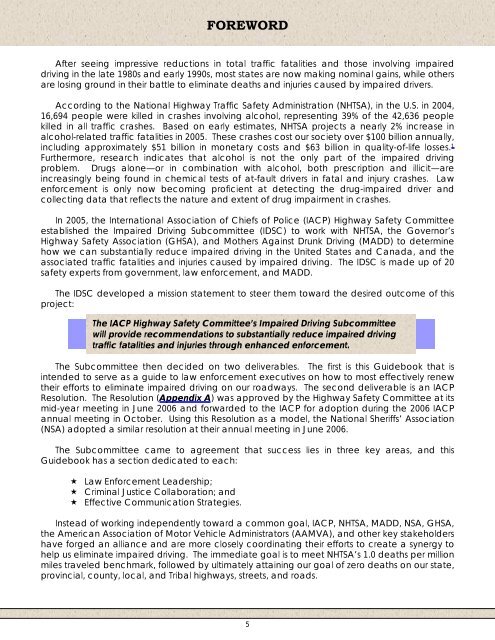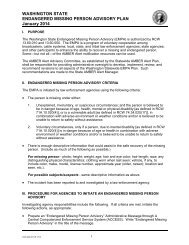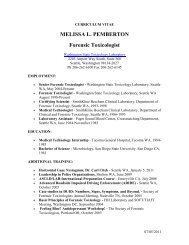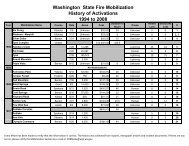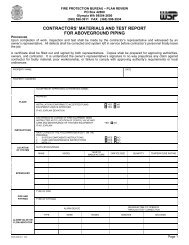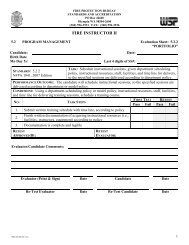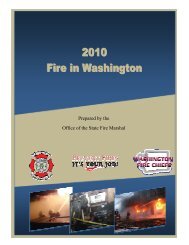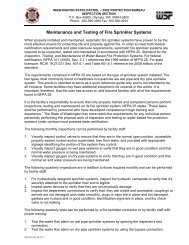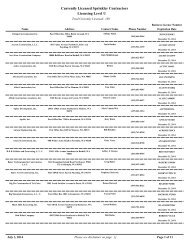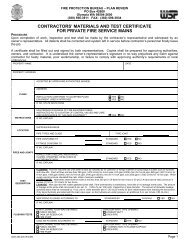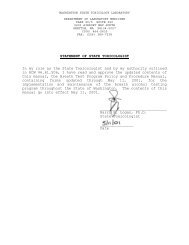Impaired Driving Subcommittee Impaired Driving Guidebook - NHTSA
Impaired Driving Subcommittee Impaired Driving Guidebook - NHTSA
Impaired Driving Subcommittee Impaired Driving Guidebook - NHTSA
Create successful ePaper yourself
Turn your PDF publications into a flip-book with our unique Google optimized e-Paper software.
FOREWORDAfter seeing impressive reductions in total traffic fatalities and those involving impaireddriving in the late 1980s and early 1990s, most states are now making nominal gains, while othersare losing ground in their battle to eliminate deaths and injuries caused by impaired drivers.According to the National Highway Traffic Safety Administration (<strong>NHTSA</strong>), in the U.S. in 2004,16,694 people were killed in crashes involving alcohol, representing 39% of the 42,636 peoplekilled in all traffic crashes. Based on early estimates, <strong>NHTSA</strong> projects a nearly 2% increase inalcohol-related traffic fatalities in 2005. These crashes cost our society over $100 billion annually,including approximately $51 billion in monetary costs and $63 billion in quality-of-life losses. 1Furthermore, research indicates that alcohol is not the only part of the impaired drivingproblem. Drugs alone—or in combination with alcohol, both prescription and illicit—areincreasingly being found in chemical tests of at-fault drivers in fatal and injury crashes. Lawenforcement is only now becoming proficient at detecting the drug-impaired driver andcollecting data that reflects the nature and extent of drug impairment in crashes.In 2005, the International Association of Chiefs of Police (IACP) Highway Safety Committeeestablished the <strong>Impaired</strong> <strong>Driving</strong> <strong>Subcommittee</strong> (IDSC) to work with <strong>NHTSA</strong>, the Governor’sHighway Safety Association (GHSA), and Mothers Against Drunk <strong>Driving</strong> (MADD) to determinehow we can substantially reduce impaired driving in the United States and Canada, and theassociated traffic fatalities and injuries caused by impaired driving. The IDSC is made up of 20safety experts from government, law enforcement, and MADD.The IDSC developed a mission statement to steer them toward the desired outcome of thisproject:The IACP Highway Safety Committee’s <strong>Impaired</strong> <strong>Driving</strong> <strong>Subcommittee</strong>will provide recommendations to substantially reduce impaired drivingtraffic fatalities and injuries through enhanced enforcement.The <strong>Subcommittee</strong> then decided on two deliverables. The first is this <strong>Guidebook</strong> that isintended to serve as a guide to law enforcement executives on how to most effectively renewtheir efforts to eliminate impaired driving on our roadways. The second deliverable is an IACPResolution. The Resolution (Appendix A) was approved by the Highway Safety Committee at itsmid-year meeting in June 2006 and forwarded to the IACP for adoption during the 2006 IACPannual meeting in October. Using this Resolution as a model, the National Sheriffs’ Association(NSA) adopted a similar resolution at their annual meeting in June 2006.The <strong>Subcommittee</strong> came to agreement that success lies in three key areas, and this<strong>Guidebook</strong> has a section dedicated to each: Law Enforcement Leadership; Criminal Justice Collaboration; and Effective Communication Strategies.Instead of working independently toward a common goal, IACP, <strong>NHTSA</strong>, MADD, NSA, GHSA,the American Association of Motor Vehicle Administrators (AAMVA), and other key stakeholdershave forged an alliance and are more closely coordinating their efforts to create a synergy tohelp us eliminate impaired driving. The immediate goal is to meet <strong>NHTSA</strong>’s 1.0 deaths per millionmiles traveled benchmark, followed by ultimately attaining our goal of zero deaths on our state,provincial, county, local, and Tribal highways, streets, and roads.5


